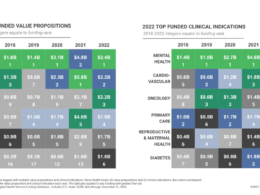The health strategist
research institute, knowledge portal & advisory consulting
for continuous health transformation
and digital health — for all
Joaquim Cardoso MSc.
Servant Leader,
Chief Research & Strategy Officer (CRSO),
Editor in Chief and Senior Advisor
January 16, 2024
Key Takeaways:
- Shift in Global Health Focus: 2022 marked a shift in global health, with deaths from noncommunicable diseases (NCDs) surpassing those caused by infections. Chronic conditions resulting from genetic, environmental, and lifestyle factors are on the rise as infectious diseases are increasingly controlled.
- Rising Impact of Chronic Diseases: Chronic conditions like heart disease, cancer, and diabetes are projected to constitute 86% of global deaths by 2050. Vaccines are seen as a potential solution to prevent or manage these diseases.
- Vaccines Targeting Rogue Proteins: Future vaccines might target our own rogue proteins associated with chronic diseases. This approach involves training the immune system against these specific proteins to prevent or mitigate the diseases.
- Success of Monoclonal Antibodies: Monoclonal antibodies, used to treat cancer and inflammatory diseases, have been successful but are expensive and administratively challenging. Vaccines are considered more accessible and scalable alternatives.
- Vaxxinity’s Vaccine Development: Vaxxinity is working on vaccines against proteins linked to Parkinson’s disease, migraine, certain hypercholesterolaemia types, and Alzheimer’s. Early data from a phase 2 trial on their Alzheimer’s vaccine candidate, UB-311, showed promising safety results.
- Avoiding T-cell Activation: Vaxxinity focuses on avoiding T-cell activation, a potential cause of harmful side effects, by using antigens that preferentially activate B-cells. This approach aims to create effective vaccines without triggering autoimmune responses.
- Alternative Vaccine Approaches: Another approach involves using virus-like particles (VLPs) to develop vaccines against chronic diseases, provoking strong and durable immune responses. Dr. Bryce Chackerian is researching VLP-based vaccines for Alzheimer’s, migraine, and cardiovascular disease.
- PCSK9 Target for Cardiovascular Disease: Both Vaxxinity and Chackerian’s group are working on vaccines against PCSK9, a protein influencing LDL cholesterol levels. These vaccines could provide an inexpensive alternative to existing treatments for cardiovascular diseases.

Challenges and Questions:
- Challenges include ensuring vaccine safety, understanding the longevity of induced antibodies, and determining the optimal timing for boosters. Human trials are essential to assess efficacy and safety.
- Preventive Vaccine Use: The long-term goal is to use these vaccines preventatively, identifying individuals at increased risk of developing diseases early on. Routine screenings, similar to cholesterol checks, could help identify those who may benefit from preventive vaccines.
- Accessible and Cost-effective Vaccines: The ultimate vision is to offer accessible, convenient, and cost-effective vaccines, potentially preventing or mitigating chronic diseases like cardiovascular disease.
- Shift in Focus from Infections to Chronic Diseases: With cardiovascular disease surpassing infections as a major threat to human health, preventive vaccines could have a significant impact on saving lives.
These key takeaways highlight the potential of vaccines in addressing the growing burden of chronic diseases and the ongoing efforts to develop effective and accessible preventive measures.
This is a republication of the article “ Vaccines show promise against common chronic diseases”, written by xxx, and published by the Gavi Alliance”

Vaccines show promise against common chronic diseases
From Alzheimer’s to heart disease, the vaccines of the future could target our own rogue proteins.
Gavi Alliance
15 January 2024
by Linda Geddes
2022 was a watershed year for global health. For the first time, deaths from noncommunicable diseases (NCDs) outnumbered those caused by infections. As vaccines and other public health interventions have increasingly brought infectious diseases under control, people are living longer and falling prey to long-term illnesses that arise from a combination of genetic, environmental and lifestyle factors, and ageing.
If the current trend continues, chronic conditions such as heart disease, cancer and diabetes are expected to account for 86% of global deaths by 2050.
“Cardiovascular disease is, by and large, preventable. If a vaccine was shown to be safe enough, you could begin vaccinating folks early on, so the accumulation of LDL cholesterol never gets to the point where you’re at high risk.”
- Mei Mei Hu, Chief Executive Officer of the US-based biotechnology company, Vaxxinity.

1.Training our immune systems
Although such diseases may attack different organ systems and trigger wide-ranging symptoms, most of them stem from the same underlying problem: “These are diseases that tend to come about because our body produces too much, too little or an abnormal version of a certain protein within us and this is typically something that continues over time,” says Mei Mei Hu, Chief Executive Officer of the US-based biotechnology company, Vaxxinity.
The answer, she believes, could be vaccines. One of the most effective health interventions going, vaccines traditionally work by training our immune systems against proteins found on the surface of pathogens such as viruses or bacteria, so that when we encounter them again, our immune cells quickly recognise and destroy them. Vaccines against chronic diseases would operate on the same principle, but rather than targeting viral or bacterial proteins, they would train our immune systems against our own rogue proteins.
Recent trials have begun putting this revolutionary idea to the test, with some promising early data in Alzheimer’s disease. Vaccines are also being developed to stall or even reverse pathogenic processes underpinning certain forms of cardiovascular disease, migraine and Parkinson’s disease.
But vaccinating against such illnesses also carries risks. Our bodies tend to avoid creating antibodies against their own proteins. When this happens naturally, it is usually in the context of an autoimmune disease. The billion-dollar question is whether such vaccines can be made to work without triggering harmful side-effects.

2.Blockbuster drugs
One reason to be optimistic is the success of targeted drugs known as monoclonal antibodies. First approved in the late 1990s, these immune-based therapies have transformed the treatment of cancer and inflammatory diseases, and monoclonal antibodies accounted for 9 of the top-selling 15 drugs in 2022. Hundreds more are being developed or have recently been licensed, including Lecanemab — an antibody proven to slow the cognitive decline associated with Alzheimer’s disease.
Manufactured in laboratories and infused or injected into the body, monoclonal antibodies mimic the pathogen-fighting antibodies that our immune cells naturally produce, except that these ones recognise and bind to some of the key proteins underpinning chronic illnesses, blocking their activity and helping to clear them from the body. Lecanemab, for instance, is delivered by an intravenous infusion (a drip bag connected to a vein) every two weeks, and binds to toxic forms of the amyloid beta protein that accumulates in the brains of people with Alzheimer’s.
The downside is that they are expensive, with the average monoclonal antibody-based treatment in the US costing around US$ 100,000 per year (the initial price for Lecanemab was set at US$ 26,000 per year). This puts them beyond the reach of most of the world’s population. “They are also generally burdensome to administer and the production of them is very limited,” says Hu. “Vaccines are more convenient, accessible and scalable than these drugs. So why not teach your body to make these antibodies?”

3.A sheep in wolf’s clothing
Vaxxinity is currently developing vaccines against the rogue proteins underpinning Parkinson’s disease, migraine and certain types of hypercholesterolaemia — a condition characterised by high blood cholesterol levels that puts people at increased risk of cardiovascular disease. But their most advanced vaccine candidate targets the amyloid beta protein that accumulates in patients with Alzheimer’s.
In August 2023, Vaxxinity published data from a phase 2 trial involving 43 people with mild Alzheimer’s disease who had been followed for 1.5 years after receiving the company’s Alzheimer’s vaccine candidate, UB-311. The study suggested that the jab was generally safe and well tolerated, with no brain swelling observed, although further studies are needed to confirm its safety and efficacy.
Vaxxinity isn’t the first company to try and develop a vaccine against amyloid beta. In 2002, a vaccine candidate developed by the Irish drugs firm Elan Pharmaceuticals was tested in 392 Alzheimer’s patients, after studies suggested it could clear brain plaques in animal models of the disease. The vaccine was abandoned after 15 patients in the trial developed potentially dangerous brain swelling.
The reason, it turned out, was T-cells. These disease-fighting cells attack their targets directly, as well as releasing chemicals that activate other parts of the immune system, triggering inflammation.
Vaxxinity has worked hard to develop vaccines that avoid T-cell activation, by steering clear of the types of targets that T-cells naturally find appealing, and focusing on ones that antibody-producing B-cells are likely to bind to instead. The company likens its approach to dressing a sheep in wolf’s clothing. Usually, immune cells would ignore the body’s own proteins, even those rogue proteins that cause disease, because they see them as harmless sheep. However, by tethering fragments of these rogue proteins to a molecule that the immune system naturally recognises as a threat, the B-cells will respond by developing antibodies against the proteins.
Time will tell if UB-311 can really prevent or reverse Alzheimer’s disease in humans. But the approach underpinning Vaxxinity’s vaccines has already demonstrated its effectiveness in animals.
Pig farmers traditionally castrate male animals to avoid a phenomenon called ‘boar taint’, where chemicals produced in their testes after puberty can adversely affect the flavour of the meat. However, surgical castration is painful and carries a risk of infection.
So, the animal health company Ceva launched a vaccine called Ceva Valora® that targets a protein called lutenising-hormone releasing hormone (LHRH). Doing so delays the onset of puberty until after the age when boars are typically slaughtered. “Farmers like it because the pigs don’t get [infections], which means they don’t stop eating, and so they gain more weight,” Hu says.
Like the vaccine candidates Vaxxinity is developing for humans, the antigen in this pig vaccine is linked to a carrier protein that preferentially activates B-cells. It has been registered for commercial use in Mexico and various countries in South America.

4.Virus-like particles
Yet, this isn’t the only approach being taken. Dr Bryce Chackerian started his research career in the lab of John Schiller, one of the inventors of the HPV vaccine, which protects against cervical cancer. Whereas many vaccines use killed or weakened viruses to stimulate an immune response, the HPV vaccine is based on virus-like particles (VLPs): viral proteins that spontaneously assemble into structures resembling a virus, yet don’t contain any of the genetic material needed to infect cells or reproduce.
One thing that impressed Chackerian about this approach was the strength of the immune response provoked by VLP-based vaccines. “There are a number of features that allow the immune system to respond very strongly to them, but probably the most important factor is that they contain these highly repetitive structures where the protein is arrayed in a geometric pattern on the VLP,” he says. “The end result is that when the immune system sees a VLP, it makes stronger and more durable immune responses. We started wondering if we might take advantage of this to develop vaccines against things that the immune system typically ignores.
Now in charge of his own laboratory at the University of New Mexico, Chackerian is attempting to develop vaccines against some of the same chronic diseases as Vaxxinity, including Alzheimer’s disease, migraine and cardiovascular disease.
One target that both groups are attempting to develop vaccines against is PCSK9, a protein that controls levels of “bad” LDL cholesterol in the blood — a key driver of cardiovascular disease. Even though cholesterol-lowering drugs such as statins exist, some people can’t tolerate them, while others have such high levels of cholesterol that these drugs can’t reduce them to low enough levels, so additional therapeutic options are needed.
People with naturally high levels of PCSK9 tend to have higher cholesterol levels and are at greater risk of heart disease compared to those with low levels of PCSK9. This discovery has led to the development of drugs that block this protein and help to reduce levels of LDL cholesterol. Over the past decade, several such drugs have been approved, including two monoclonal antibody-based therapies — evolocumab and alirocumab. But these are expensive: “When they were first introduced in the US, treatment cost $14,000 per year, and monoclonal antibodies also need to be administered fairly frequently,” says Chackerian. “Cardiovascular disease is a huge problem around the world and a vaccine could provide an inexpensive alternative to some of these approaches.”
To make their vaccines, Chackerian and his colleagues use VLPs from a simple type of virus, called a bacteriophage, that only infects bacteria and is harmless to humans. They also manufacture fragments of PCSK9 protein called peptides that the immune system is likely to respond to, and chemically attach hundreds of them to each VLP. One recent study in non-human primates suggested that a vaccine combining several different PCSK9 peptides lowered cholesterol levels by 30%.

5.A question of timing
One thing that makes him optimistic about this approach is that people who are born with mutations in the PCSK9 gene are healthy — they just have very low cholesterol levels. Experience with monoclonal antibodies against PCSK9 also suggests that this approach is safe.
Even so, human trials are needed. Besides efficacy, a key question will be how long the antibodies induced by such vaccines remain in the body, and what the longer-term consequences of their presence might be.
“
Even though I keep touting the advantage of vaccines being that you get these long-lived antibody responses, we do eventually see the antibody levels go down; we’ve calculated that the half-life of the antibodies — the time it takes for the amount in the body to reduce by half — is about 20 weeks or so,” Chackerian says.
While this means people may require regular boosters, the hope is that these would be needed less frequently than infusions of monoclonal antibodies, and that the price of the vaccines would be lower.
“
The idea would be to provide a vaccine for folks that is accessible, convenient and cost-effective, and where if you can vaccinate people early enough, you can basically prevent heart disease,” says Hu.
Another question is who would be offered such an intervention. While the first step will be demonstrating efficacy in patients in the early stages of diseases such as Alzheimer’s or heart disease, the longer-term goal is for such vaccines to be used preventatively in individuals identified as being at increased risk of developing a given disease.
“
Just like today we go to the doctor and get blood tests to see how our cholesterol is, and if it is too high the doctor can prescribe a statin, I see something very similar with a vaccine for Alzheimer’s disease, where if a blood test detects high levels of amyloid, we start trying a vaccine,” says Hu.
She can even envisage a future where most adults above a certain age were offered an annual shot to lower levels of harmful cholesterol in their bodies. “Cardiovascular disease is, by and large, preventable. If a vaccine was shown to be safe enough, you could begin vaccinating folks early on, so the accumulation of LDL cholesterol never gets to the point where you’re at high risk,” Hu says.
As cardiovascular disease overtakes infections as the greatest threat to human health, a preventive vaccine could save countless lives. Although developing such vaccines is unlikely to be straightforward, the death of heart disease is surely worth a shot.
Originally published at https://www.gavi.org on January 15, 2024.












